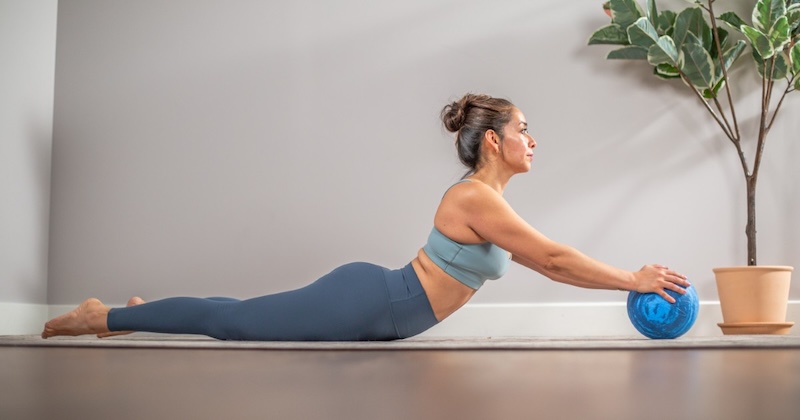Pilates for Beginners – How to Start Practicing at Home? – Starting something new always brings a mix of curiosity and hesitation. When it comes to Pilates, that hesitation often stems from one question: Do I need to go to a studio to start, or can I just begin at home? The good news is that Pilates for beginners can be practiced almost anywhere – all you need is a mat, some space, and a bit of patience. Pilates is not about perfection but awareness – about learning how to move intelligently, breathe consciously, and build stability from the inside out. It’s a training system that doesn’t demand youth, strength, or flexibility. It rewards consistency and focus, gradually reshaping the body and mind.
Whether your goal is to relieve back pain, improve posture, or simply feel lighter and stronger, home Pilates practice is an excellent first step. You don’t have to know every exercise or own expensive equipment to start. The foundation of Pilates lies in mindful movement – something you can learn in your living room, step by step, with clear guidance and the right approach.
Why start Pilates at home?
For many beginners, home practice feels safer and less intimidating than stepping into a studio full of reformers and advanced practitioners. Pilates at home gives you time to explore your body’s capabilities at your own pace, without comparison or pressure. You can start slow, focusing on learning the technique and building awareness before increasing intensity. With access to countless online resources, video classes, and digital programs from professional instructors, starting Pilates at home has never been easier.
The main advantage? Flexibility – you decide when and how long you train. Morning before work, evening after a long day, or even ten minutes during a break – every session counts. Regularity matters far more than duration. Practicing three times a week for 20 minutes will bring faster and safer results than an intense two-hour workout once a week. Pilates adapts perfectly to your schedule and energy levels, and its effects grow with time: improved posture, reduced tension, better mobility, and a calmer, more focused mind.
The foundations of Pilates – what to focus on at the start?
Before jumping into exercises, it’s important to understand what makes Pilates different from other workouts. It’s not about the number of repetitions or how fast you move – it’s about how precisely you move. Every exercise begins with core activation, known as the Powerhouse: the deep muscles of the abdomen, lower back, pelvis, and diaphragm. These muscles work like an internal stabilising belt, supporting the spine and helping the body move efficiently.
In addition to core engagement, Pilates emphasises controlled breathing. Each inhale and exhale supports the movement. Beginners often underestimate how much the breath influences posture and muscle tone – but learning to coordinate the two transforms the entire experience. Finally, there’s alignment and awareness. You’ll learn to notice how your shoulders sit, how your pelvis tilts, and how your weight distributes between your feet. With each session, your movements become more fluid, your posture more open, and your body more balanced – even outside of practice.
What you need to start?
Starting Pilates at home doesn’t require a studio full of equipment. The basics are simple and affordable. However, investing in a few small accessories can make your practice more effective and enjoyable.
Here’s what you’ll need to begin safely and comfortably:
- Mat: Choose a thicker Pilates or yoga mat (at least 10 mm) to protect your spine and joints.
- Comfortable clothing: Flexible, form-fitting clothes allow free movement and help you observe alignment.
- Small props: A Pilates ball, resistance band, or foam roller can enhance body awareness and add variety to your routine.
- Quiet space: Find a place where you can focus without distraction – mindfulness is key to every movement.
- Guidance: Use beginner-friendly online classes or written programs to learn correct breathing and core engagement.
As you progress, you can expand your setup with equipment like the Balanced Body reformer, which allows for deeper, more controlled work. But at the beginning, your own body is the best teacher – it tells you where tension lies and where strength needs to grow.
Core principles every beginner should remember
Learning Pilates at home requires discipline and awareness, especially without an instructor’s supervision. Before each session, take a moment to ground yourself – feel your body, notice your breath, and set an intention for the practice. Then follow these principles:
- Less is more. Don’t chase speed or exhaustion. Each exercise should feel smooth and precise.
- Engage your center. Imagine pulling your navel gently toward your spine – that’s your Powerhouse at work.
- Breathe consciously. Inhale through your nose, expanding the ribs; exhale through your mouth, engaging your core.
- Move with control. Avoid jerky, rushed movements. Control every inch of motion.
- Stay consistent. Progress in Pilates comes through repetition – small steps practiced regularly build lasting change.
These five foundations will help you build not just strength but also awareness – the true essence of Pilates.
Simple home Pilates exercises for beginners
When starting out, focus on foundational movements that awaken the core, mobilise the spine, and teach coordination. They don’t require equipment and can be done on any mat.
Try these six classic beginner-friendly Pilates exercises:
- Pelvic Tilt (Imprint): Lying on your back, exhale and gently flatten your lower back against the mat, activating your abs. Builds stability and eases lower-back tension.
- Bridge (Shoulder Bridge): Lift your hips, vertebra by vertebra, keeping the abdominals engaged. Strengthens glutes and spine stabilisers.
- Cat–Cow: On all fours, alternate between rounding and extending your spine with breath. Improves mobility and relieves stiffness.
- Spine Twist: Sitting tall, rotate the torso gently to each side, maintaining long posture. Engages obliques and improves spinal rotation.
- Leg Slides: Lie down, engage the core, and slowly slide one foot away, then return. Enhances pelvic control and deep abdominal stability.
- Hundred Prep: Lying on your back, lift your head and shoulders slightly, engage the abs, and pulse your arms in rhythm with your breath. Builds endurance in the core and improves breathing coordination.
These foundational exercises teach the key mechanics of Pilates and can form a short 15–20-minute home sequence. Always prioritise technique over quantity—quality movement leads to lasting results.
How often to practice Pilates at home?
Consistency is everything. For beginners, two to three sessions per week are enough to start feeling the difference. You’ll likely notice changes in posture, tension, and body awareness within the first few weeks. Once your technique becomes more refined, you can increase to four or five shorter sessions per week or mix Pilates with other activities like walking or yoga.
It’s worth remembering that Pilates is a lifelong method, not a quick fix. Each session builds not just muscle tone but deeper neuromuscular coordination. The more regularly you practice, the easier it becomes to maintain correct posture, move efficiently, and keep your spine supported without conscious effort.
When to consider professional guidance?
Even if you start at home, scheduling a few one-on-one lessons with a certified instructor can make a world of difference. A professional can assess your posture, correct mistakes, and teach you to engage the right muscles. This is especially helpful if you have back pain, injuries, or limited mobility.
Studios equipped with Balanced Body reformers, chairs, and barrels allow you to explore new levels of movement safely and efficiently once you’re ready. Combining occasional in-studio sessions with regular home practice is an ideal long-term strategy—it offers both precision and flexibility.
The benefits of starting Pilates at home
Starting Pilates in your own space builds confidence and self-discipline. You learn to listen to your body instead of relying on mirrors or external feedback. With time, you’ll notice subtle yet powerful transformations:
- a stronger, more stable core,
- reduced back and neck tension,
- better balance and coordination,
- a calmer mind and improved concentration,
- and a greater sense of connection between movement and breath.
Home Pilates practice can also become your daily reset ritual – ten minutes to stretch, breathe, and realign your body after work or before sleep. These quiet moments of mindful movement not only strengthen the body but also reduce mental fatigue and stress.
A strong start for a stronger you
Pilates for beginners at home is not about complicated routines or perfection. It’s about building awareness, step by step. The more you practice, the more your body and mind begin to cooperate, creating a sense of ease and lightness that carries into daily life.
Start small. Choose a few exercises, breathe deeply, and move slowly. Over time, your posture will improve, your core will strengthen, and your movements will feel effortless. In a world full of noise and rush, Pilates offers a moment of calm clarity—a return to yourself. Because true strength begins not in the muscles, but in awareness—and that awareness starts the moment you step onto the mat.
This post was created in collaboration with balanced-body.ee
Poppy Watt


